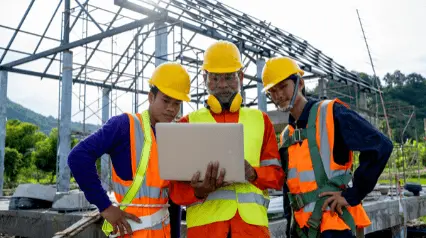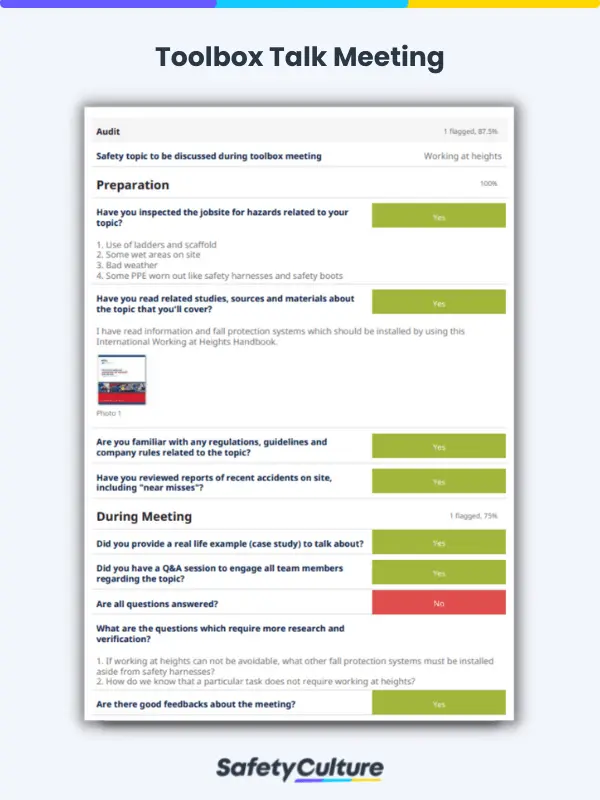What is a Toolbox Talk?
Toolbox talks are quick and easy to understand work safety meetings conducted before a shift. Also known as safety briefings, pre-start, or take 5 safety talks, a toolbox talk is ideally conversational in tone and takes about 5-10 minutes of engaging workers to discuss their awareness of health and safety risks associated with their tasks.
Importance and Purpose
Regular toolbox talks aim to discuss workplace hazards, the best way to address them, and ideal ways to keep workers safe. According to the Safe Work Australia and the UK Health and Safety Executive (HSE), these talks are a major key to reducing workplace incidents.
In addition to identifying immediate hazards for the day, an effective toolbox talk can help with the following:
- Growing a positive safety culture within an organization
- Keeping all workers alert
- Improving team communication and productivity
- Reminding workers and employers of their duties and responsibilities
- Providing an updated record of hazards and action plans
Improve your EHS Management
Cultivate a safe working environment and streamline compliance with our EHS solutions.
Explore nowCommon Toolbox Talk Topics
Topical items for discussion can be identified by asking workers for input, identifying changes in the plant, work process, or work environment, and developing actions in response to accidents or incidents in the workplace.
While you can conduct general safety toolbox talks, it helps to focus on the right topic for regular work-specific hazards. Here are some of the most common toolbox talk topics and ideas:
1. Construction Safety Toolbox Talk Topics
Construction workers are exposed to different health and safety hazards on site that, if not properly mitigated, may cause incidents, injuries, or fatalities. Common topics discussed for toolbox topics in the construction field include the following:
- Top causes of falls
- Causes of electrocution
- What to do when struck by an object or caught between objects
- Preventive tips on how to avoid these common incidents
2. Slips Trips and Falls Safety Toolbox Talk Topics
Slips, trips, and falls are some of the most common causes of accidents in the workplace and often the most overlooked hazard. Because of this, these safety incidents merit their own toolbox talk.
For this topic, discuss with your team the most common types of slip injuries and have them point out any hazards at work. Get your team to suggest methods to prevent these measures.
3. Electrical Safety Toolbox Talk Topics
Electrocutions account for one of the most common injuries seen on construction sites. Discussing this topic during your toolbox talk helps remind every worker about the hazards of electricity and the preventive measures when getting in contact with it.
Remind your team of the basics of electrical safety, discuss lock-out tag-out procedures, list all major hazards, and ask the team to identify any pre-shift or pre-start issues.
4. PPE Safety Toolbox Talk Topics
Personal Protective Equipment (PPE) is used to reduce employees’ exposure to hazards. Thus, before work, employers must properly discuss how to use them and emphasize their importance in keeping them safe at work.
This toolbox topic can help inform employees about the guidelines and conditions of each PPE and record faulty equipment for repair or replacement.
5. Working at Heights Safety Toolbox Talk Topics
For work that involves heights, it’s important to have toolbox talks that discuss its dangers, all appropriate safety measures in place, and the proper use of fall protection equipment.
6. Confined Space Safety Toolbox Talk Topics
It’s essential to conduct safety toolbox talks before sending workers to work in confined spaces, for this line of work exposes them to various deadly gases and oxygen deficiency.
For this toolbox talk topic, discuss all hazards present in the confined space and agree as a team on how to address them in different situations. You and your safety personnel can also use a confined space safety checklist to supplement your toolbox talk. It can work as a guide to conduct their talks daily and record key action points.
7. Accident Reporting Toolbox Talk Topics
Proper accident and incident reporting should also be included in your toolbox talks. Empower your employees to report incidents effectively by answering the following questions:
- “What do I report?”
- “Who do I report it to?”
- “When do I report?”
Use an accident and incident reporting checklist to assist your employees in properly documenting accidents in the workplace.
8. Asbestos Awareness Toolbox Talk Topics
Asbestos is known as a hidden killer that can put both employees and businesses at risk. Given the risk it presents to the worker’s health, this toolbox talk topic is crucial, especially in the construction and manufacturing industries.
Create and share a toolbox talk that shares awareness of asbestos, such as the different types of asbestos-containing materials that workers may come in contact with.
9. COSHH Toolbox Talk Topics
Workplaces have the potential to produce hazardous substances, whether from cleaning chemicals or dust and gases. Common toolbox talk topics for the Control of Substances Hazardous to Health (COSHH) include the following:
- Identifying which tasks involve hazardous substances
- How to assess COSHH risks
- Risks of each substance
- How to reduce the risks of harm occurring
10. Excavation Toolbox Talk Topics
Industries involved in building sites should ensure worker safety by using this as a topic in their toolbox talks. During your team’s toolbox talk, be sure to go through the general requirements for excavation safety.
Streamline your toolbox talks with an excavation safety checklist. You can also use it to perform worksite and equipment inspections and ensure utilities, barriers, walkways, and warning systems are in place.
11. Fire Extinguisher Toolbox Talk Topics
In the event of fire incidents, employers expect their employees to use fire extinguishers. Using this as a topic for toolbox talk can help employees get details in terms of its location and their roles during fire emergencies.
Discuss with your employees the different types of fire and the appropriate extinguisher to use. It also helps to use checklists for identifying defects on tags and seals on fire extinguishers and ensure they’re safe for use.
12. Fire Safety Toolbox Talk Topics
Raise awareness of fire risks and discuss with your team the different types of fire safety issues that may occur in the workplace. You can discuss fire prevention methods to mitigate fire-related risks and avoid injuries and accidents.
13. First Aid Toolbox Talk Topics
Discuss this topic amongst your team to ensure everyone knows basic first aid arrangements in place. During your toolbox talk, cover the following:
- Location where first aid equipment and supplies are stored
- Emergency contacts in case of a serious injury
- Objectives to administer when providing first aid to an injured person until professional help arrives
14. Forklift Safety Toolbox Talk Topics
Before starting work that involves forklifts, discuss the following with your team:
- Basic forklift safety practices
- Blind spots to forklifts
- Standard safety practices
- Forklift maintenance tasks
15. Housekeeping Toolbox Talk
A disorderly work environment not only lowers morale but also may result in employee injuries or, worst-case scenario, death.
To avoid this, you can conduct safety talks that cover general housekeeping rules and best practices. During your toolbox talk, you can also discuss the effects of poor housekeeping practices to emphasize the importance of proper housekeeping.
16. Manual Handling Safety Toolbox Talk
One of the most common injuries across industries relates to pain, strain, and injuries to the back from improper twisting, turning, lifting, carrying materials, or digging.
During your toolbox talks, make sure to discuss and demonstrate the best practices for manual handling. You can also outline the best ways to identify and evaluate risk factors of manual handling in your workplace.
Create Your Own Toolbox Talk Checklist
Eliminate manual tasks and streamline your operations.
Get started for FREEDocumenting Toolbox Talk Meetings
Toolbox talks can be carried out differently depending on the topics to be discussed and the type of work to be done. It’s important, however, that all talks and meetings are documented for future reference and tracking past hazards or concerns.
Here is a basic example of a toolbox talk meeting recorded specifically for people working in confined spaces:
Role of Training in Toolbox Talks
Toolbox talks training, also known as safety toolbox talks or simply toolbox talks, is a short safety training session that’s typically conducted on a regular basis in workplaces. These sessions are designed to promote safety awareness, educate workers about potential hazards, and reinforce safe work practices.
On a broader perspective, toolbox talks and training contribute to the development of a strong safety culture within an organization. When safety is prioritized and openly discussed, employees are more likely to take it seriously and watch out for each other.
Today, you can use digital tools to create training programs that’s accessible anytime and anywhere, promoting a culture of learning and safety at all levels. By integrating these digital courses into your working systems, you can supplement your toolbox talks with the right safety tools and empower employees to take charge of their safety.
FAQs About Toolbox Talks Topics
Toolbox talk topics are often decided beforehand by employers and safety officials, depending on the work to be done. Doing so helps streamline the meeting. However, the employees can also have a say in choosing the toolbox talk topics depending on their needs and concerns.
Toolbox talks are usually led by the supervisor, manager, safety coordinator, or designated safety representative from the organization. In some cases, workers may also be asked to lead toolbox talks, especially if they have extensive knowledge or experience related to the topic—which can also promote worker engagement and participation in the safety process.
Health and safety professionals recommend that toolbox talk meetings be conducted daily, weekly, or as often as the business needs. They are also highly dependent on the nature of work, job, or task, as well as the level of risks involved.
The three-point contact rule is a safety topic that’s often discussed during toolbox meetings involving working at heights. This safety procedure emphasizes that workers should always have three points of contact with a stable surface at all times to reduce the risk of falling.





